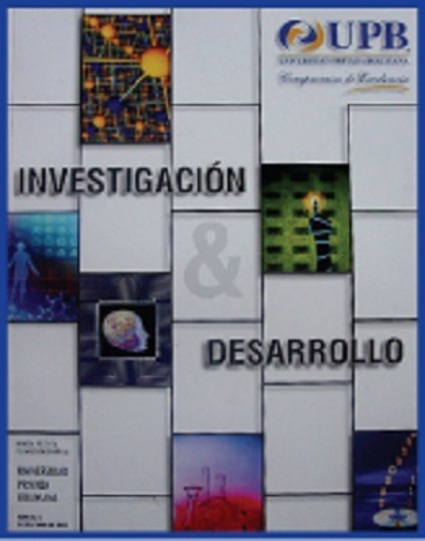A NEW METHOD FOR AUTOMATIC DETECTION OF THE ELECTROCARDIOGRAM (ECG) CHARACTERISTIC POINTS
Palabras clave:
Electrocardiogram, ECG, Neural Networks, Wavelet TransformResumen
In this article we propose a new method based on wavelet transform and on neural networks to detect the maximum, onset and offset of electrocardiogram (ECG) characteristic waves. First, the wavelet transform modulus maxima is used to extract main information of the ECG. We use Neural Networks to discern important modulus maxima and with them, the maximum point of a wave is detected. Then, a forward and backward search is made to detect the onset and offset of ECG waves. The detection degree of the maximum of the waves was proved using the QT Database and compared with another method. As a result, the proposed method can work with several morphologies of highly noisy ECGs.Descargas
Referencias
J. A. Castillo. “Metodología para la interpretación automática de electrocardiogramas basado en la discriminación trigonométrica de módulos máximos de la transformada wavelet usando redes neuronales,” Bachelor thesis, Universidad Privada Boliviana, 2001.
G. M. Friesen et al. “A comparison of the noise sensitivity of nine QRS detection algorithms,” IEEE Trans. Biomed. Eng., Vol. 37, Jan. 1990.
R. Jané et al. ''Evaluation of an automatic threshold based detector of waveform limits in Holter ECG with the QT database,'' Computers in Cardiology, 1997, pp. 295-298.
M. G. Khan. Interpretación Rápida del ECG. Mexico, McGraw-Hill Interamericana, 1998.
D. Kilpatrick and P. R. Johnston. ''Origin of the electrocardiogram,'' IEEE Engineering in Medicine and Biology Magazine, Vol. 16 No.1, Jan.-Feb. 1997, pp. 77-83.
H. Dickhaus and H. Heinrich. ''Analysis of ECG Late Potentials Using Time-Frequency Methods,'' Time Frequency and Wavelets in Biomedical Signal Processing. Edited by Akay M., NY., IEEE Press, 1998, pp. 101-115.
A. Golderberg et al. ''PhysioBank, PhysioToolkit, and Physionet: Components of a New Research Resource for Complex Physiologic Signals''. Circulation, [On-line], vol. 101, no. 23, e215-e220 [Circulation Electronic Pages;
http://circ.ahajournals.org/cgi/content/full/101/23/e215]
P. Laguna et al. ''A Database for Evaluation of Algorithms for Measurement of QT and other Waveform Intervals in the ECG, '' Computers in Cardiology, 1997, pp. 673-67.
C. Li et al., ''Detection of ECG characteristic points using wavelet transforms,'' IEEE Trans. on Biomed. Eng., Vol. 42 No.: 1, Jan. 1995, pp. 21-28.
Physionet, The MIT-BIH Noise Stress Test Database. Internet:
http://www.physionet.org/physiobank/ database/nstdb
H. Demuth and M. Bealy. ‘’Neural networks toolbox for use with MATLAB,’’ Matlab users guide. Version 4. Sep. 2000.
J. S. Sahambi et al. ''Using wavelet transforms for ECG characterization. An on-line digital signal processing system,'' IEEE Engineering in Medicine and Biology Magazine, Vol. 16, No. 1 , Jan.-Feb. 1997, pp. 77-83.
J. S. Sahambi et al. ''A new approach for on-line ECG characterization,'' Biomedical Engineering Conference, Proceedings of the 1996 Fifteenth Southern, 1996, pp. 409-411.
S. Mallat. ''Zero-crossings of a wavelet transform,'' IEEE Trans. on Information Theory, Vol. 37 No. 4, Jul. 1991, pp. 1019-1033.
S., Mallat and W. L. Hwang. ''Singularity detection and processing with wavelets,'' IEEE Trans. on Information Theory, Vol. 38 No.: 2 Part. 2, Mar. 1992, pp. 617-643.
J. W. Williams. ''Recent Advances in Time-Frequency Representations: Some Theorical Foundations,'' Time Frequency and Wavelets in Biomedical Signal Processing. Edited by Akay M., NY., IEEE Press, 1998, pp. 1-43.
C. Mello and A. Metin. ‘’Recent advances in Time-Frequency and Time-Scale Methods, ‘’ Metin, edited by Akay M. NY., IEEE Press, pp 183-207.
Uhrig. ''Introduction to artificial neural networks,'' Proceedings of the 1995 IEEE IECON 21st International Conference on Industrial Electronics, Control, and Instrumentation, 1995, Vol. 1, pp. 33-37.
Descargas
Publicado
Número
Sección
Licencia
Reconocimiento-NoComercial-CompartirIgual
CC BY-NC-SA
Esta licencia permite a otros entremezclar, ajustar y construir a partir de su obra con fines no comerciales, siempre y cuando le reconozcan la autoría y sus nuevas creaciones estén bajo una licencia con los mismos términos.
Los autores pueden realizar acuerdos contractuales adicionales separados para la distribución no exclusiva de la versión publicada del artículo publicado en la revista (por ejemplo, publicarlo en un repositorio institucional o en un libro), sujeto a un reconocimiento de su publicación inicial en esta revista
